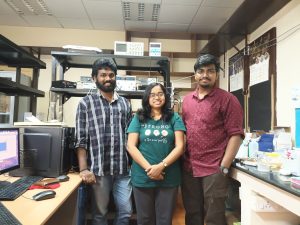
Leukocytes, which are cells of the body’s immune system, have a tendency to roll on the endothelial cells lining the wall of the blood vessel towards the site of inflammation. The primary mechanism of rolling is due to adhesion at the wall while the shear flow due to the blood induces motion. This mechanism has been studied for nearly twenty years because the rolling of the cell in the inflammatory response and cancer metastasis could be better understood.
Rolling adhesion can be used to sort cells based on their receptor expressions. However, it has been difficult to study the exact rotation angles of the cells. Usually, to study such interactions which go in the range of nanoscales, Atomic Force Microscopy (AFM) is used. The sharp tip of this microscope is pressed against a surface, and gradually retracted. The force required to pull it away is recorded as the force of adhesion.
There are drawbacks to using an atomic force microscope. Although it gives an insight into the nanoscale forces, a large force is required to press against the surface called “hard probing”. But what happens in the biological systems is actually “soft probing”. This means that the forces of rolling adhesion of cells are of a very low range.
In this study, Mr. Lokesh Muruga, Mr. Gokul Nalupurackal, Ms. Sreshta Roy, and Prof. Basudev Roy, from the Department of Physics, Indian Institute of Technology Madras, Chennai, India, study a 3 micrometre birefringent particle which is optically trapped on the surface of the sample chamber, and is moved to generate rolling motion of the particle. A perpendicular force, generating a torque is used to rotate the particle on the surface. Rolling of the particle was tried on different surfaces, including a hydrophobic slippery surface called polydimethyl siloxane (PDMS). Diamonds of 500 nanometres diameter were also used as particles in this experiment.


Rotational motion called the pitch rotation, where the rotational motion is out of the plane was done. OTKB/M optical tweezers were used for soft probing. A diode laser was also used and was linearly polarized to ensure that the birefringent particle axis was aligned with it.
In this experiment, soft probing of birefringent particles was achieved and the rolling adhesion was studied. This was studied and done at nanoscale levels and was successful and better than atomic force microscopy. This study can be used to further study the adhesive properties of cells like leukocytes when rolled on different surfaces. Interaction between binding molecules and optical resolution of particles like diamonds can also be further studied.
Dr. G. V. Pavan Kumar, from the Department of Physics, Indian Institute of Science Education and Research (IISER), Pune, India, appreciated the work done by the authors in this study by giving the following comments: “Quantifying adhesive forces on a surface or an interface is important to understand how objects stick and/or slip. Measuring such forces at micro and nanoscale surfaces remains a major challenge. Conventionally, cantilever tip based approaches, such as AFM have been used, which are suitable for measurement at limited spatial and temporal scales. There is an imperative to develop optical force/torque based approaches that can be minimally invasive, flexible in movement and competitive in spatio-temporal resolutions. The approach used by Basudev Roy and coworkers is innovative in that they harness the rotational motion of an optically trapped birefringent (submicron) object and use its rotation to quantify the adhesivity at the surface. From a technical viewpoint, this is indeed a promising approach and can gain further ground by improving the spatial length scales of the trapped object down to a few nanometers.”
Article by Akshay Anantharaman
Here is the original link to the paper:
https://pubs.rsc.org/en/content/articlelanding/2021/RA/D1RA06960H









